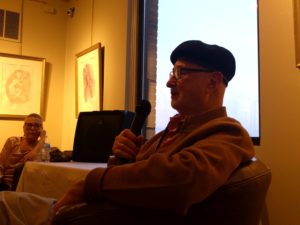I Want to Grow Old Like Jules Feiffer
When gallery owner Richard Michelson asked Jules Feiffer if he wanted a retrospective for his 89th birthday, the brilliant artist replied, “I am doing the best work I’ve ever done and want this exhibit to be new and explosive, with figures sprawling and flying everywhere, and focused on dance…It only took 89 years to figure out how to do this stuff!”

That wonderful and extensive show is now on display at R. Michelson Gallery in Northampton, Massachusetts. We went in to peruse it, and Rich’s wife Jennifer told us that Feiffer was about to do a Q&A. Of course we went upstairs, chatted a bit with Jules and his Phantom Tollbooth collaborator Norton Juster (who lives locally), and settled in to listen.
Jules has a quick and acerbic wit and a strong sense of social justice. Someone asked him what the best response was to the current situation in national politics and he instantly responded with a primal scream. I asked him how he was able to capture the 3-dimensional, flowing art of dance so well in static two-dimensional pictures and he talked about capturing the illusion, that everything was an illusion.
His new work is indeed brilliant. While it descends directly from his famous Village Voice cartoons of he 1960s and 70s, it really is what he told Rich. It has so much vibrancy, often very sophisticated and detailed captioning, and the figures really come alive—especially those using colored inks, which he’s begun to use here and there (though most of the show was black-and-white).
Jules is the latest in a long line of inspirational role models for growing older. I’ve profiled some of them here: Arky Markham, centenarian and activist; Bob Luitweiler, founder of the international homestay organization Servas, for instance I’ve been fortunate to know many others, including Pete Seeger and Chicago Seven/Eight defendant Dave Dellinger—with whom I became friends as a teenaged college student when he was 60, and whom I consider one of my personal mentors—as well as Gray Panther founder Maggie Kuhn; I met her when I was working for the Gray Panthers as a VISTA Volunteer, at the group’s national conference.
These are the kinds of people I want to emulate as I (hopefully) reach well past my current age of 61. When I was a teen activist, I often heard that I was too young to change the world. Now, I’m beginning to hear people tell me I’m too old to do the work I do. But I remind them that Grandma Moses started painting in her 70s and enjoyed a 20-plus-year run as a painter. Today, for example, I’m going networking at a sustainability fair, then attending a peace and tax fairness rally, then hiking a mountain, and probably going out to hear some live music or theater in the evening. You’re only as old as you feel.
